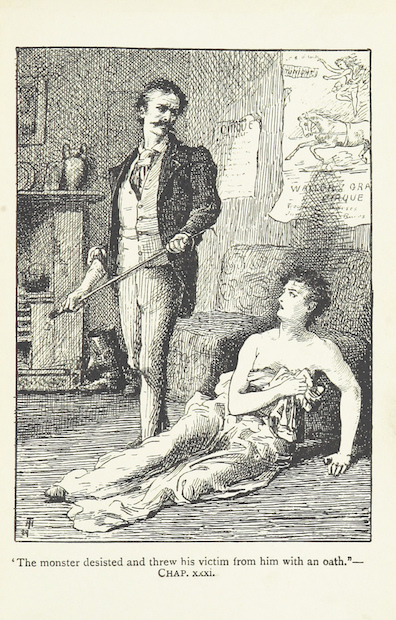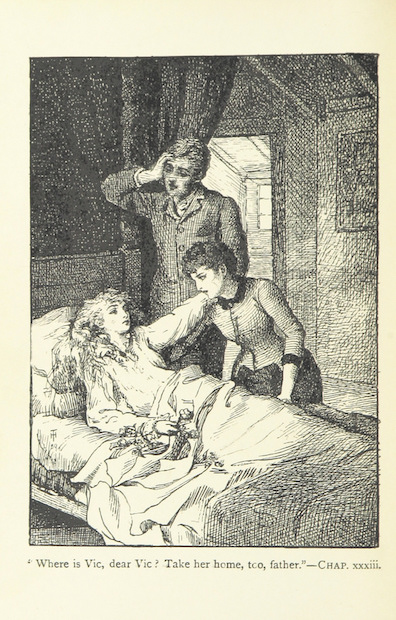Thumbing through Molly's book in Calypso, Bloom
comes across an interesting plate: "Fierce Italian
with carriagewhip. Must be Ruby pride of the on the floor
naked." Beneath the picture he reads the sentence
which it illustrates: "The monster Maffei
desisted and flung his victim from him with an oath."
Joyce added the name Maffei to the caption. He slightly
changed the title of the book, and made Bloom mistake the
identity of the naked woman on the floor. But these small
changes do not detract from the central message of Reade's
novel. Bloom shares her revulsion at inflicting suffering on
human beings (and animals) to promote the thrills of public
entertainment: "Cruelty behind it all. Doped animals.
Trapeze at Hengler's. Had to look the other way. Mob
gaping. Break your neck and we'll break our sides."
Reade's novel tells the story of how Ruby Hayward, the
daughter of an ideal father and a horrible mother, is sold
into slavery at the tender age of thirteen to Signor Enrico, a
circus master. Enrico treats his indentured servant as he
would an animal, driving her to exhaustion and beating her
when she does not meet his expectations. Utterly worn out, she
falls from a horse just when her father Jack has conveniently
returned from Australia and decided to attend the circus, not
knowing that his daughter is employed there. He and Ruby's
fellow rider and friend, Victoria Melton, attend Ruby on her
deathbed, and Reade ends the novel happily by marrying Vic to
Jack and giving the couple a daughter whom they name Ruby.
Passing up the opportunity to associate the evil Enrico with
Henry Flower, Joyce changed his name to Maffei, which Gifford
speculates may suggest mafiosi.
Enrico strips his girls naked before beating them, but,
incredibly, the novel never suggests that he is sexually
abusing them. The illustration by Talbot Hughes manages to
make the suggestion, although he covers the naked Vic with a
sheet for decency's sake. This titillating detail catches
Bloom's attention: "Hello. Illustration." So,
in addition to giving Joyce a vehicle (one of many) for
presenting Bloom's compassionate responses to the sufferings
of other sentient creatures, the novel also ties into the masochistic aspect of
Bloom's sexuality.
The sadomasochistic implications of Ruby are
developed in Circe, where, by the kind of
associative logic that Sigmund Freud saw operating in dreams,
the circus ring where Ruby performs becomes a wedding ring
signifying domination. When Bloom compensates for Molly's
betrayal by playing the Don Juan with Josie Breen (what
Stephen calls "assumed diongiovannism" in Scylla
and Charybdis), he marks his conquest with a ring: "(Tenderly,
as he slips on her finger a ruby ring.) Là ci darem la mano."
Later, when he is crowned king of Ireland, the ring adorns
Bloom's hand, to signify his power: "Bloom assumes a
mantle of cloth of gold and puts on a ruby ring.
He ascends and stands on the stone of destiny."
But the ring is most at home representing Bloom's submissive
tendencies. When Bella Cohen becomes Bello and Bloom becomes
one of her girls, she names him Ruby: "What you longed for has
come to pass. Henceforth you are unmanned and mine in earnest,
a thing under the yoke. Now for your punishment frock. You
will shed your male garments, you understand, Ruby
Cohen? and don the shot silk luxuriously rustling
over head and shoulders. And quickly too!" Bloom's
transformation into a woman, which figuratively expresses his
tendency to abase himself before beautiful women, is sealed
when Bello places a ring on his finger: "By day you will souse
and bat our smelling underclothes also when we ladies are
unwell, and swab out our latrines with dress pinned up and a
dishclout tied to your tail. Won't that be nice? (He
places a ruby ring on her finger.) And
there now! With this ring I thee own. Say, thank you,
mistress."
Ruby's story implicitly addresses not only men's domination
of women, but also the conventions of clothing by which women
are made sexually alluring to men and defined as subordinate
beings. Ruby resists the revealing toy-doll costume which she
is expected to wear in the circus, to no avail. Bello subjects
Bloom to the same objectifying conventions: "As they are now
so will you be, wigged, singed, perfumesprayed, ricepowdered,
with smoothshaven armpits. Tape measurements will be taken
next your skin. You will be laced with cruel force into
vicelike corsets of soft dove coutille with whalebone busk to
the diamondtrimmed pelvis, the absolute outside edge, while
your figure, plumper than when at large, will be restrained in
nettight frocks, pretty two ounce petticoats and fringes and
things stamped, of course, with my houseflag, creations of
lovely lingerie."
In developing these implications of the Ruby story, Joyce may
have been influenced by The Subjection of Women
(1869), the book that John Stuart Mill wrote with his wife
Harriet Taylor Mill. The Mills likened marriage laws to
slavery, and argued that "woman" is to a very large degree a
social construction.
The source of Joyce's Ruby was discovered by Mary
Power, who published an article titled "The Discovery of Ruby"
in James Joyce Quarterly 18.2 (1981), pp. 115-21.
Among other comments, Power observes that, although the word
"metempsychosis" does not appear in Reade's novel, it does
seem appropriate to what she is doing. Amye Reade "anticipates
Joyce's interest in changes of state," and she reincarnates
Ruby as Jack's new daughter, showing that "future generations
can overcome past tragedies" (121).
It seems quite likely that Joyce acknowledged this
transmigration of souls with one final, faintly audible
allusion in Circe. When Bloom has a vision of his
dead son at the end of the chapter, a vision prompted by
gazing on Stephen with paternal interest, the association
between Rudy and ruddy
coloration adds touches of deep red to the boy's figure: "He
has a delicate mauve face. On his suit he has diamond and
ruby buttons." Rudy is Bloom's Ruby, and
like Jack Hayward he has a chance to renew him in the present.


